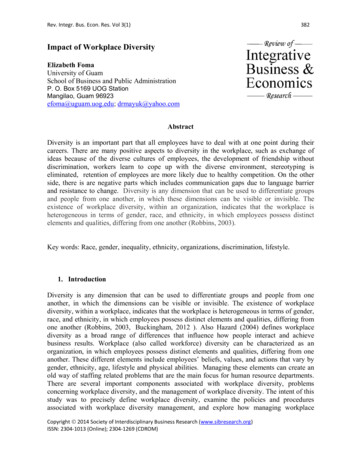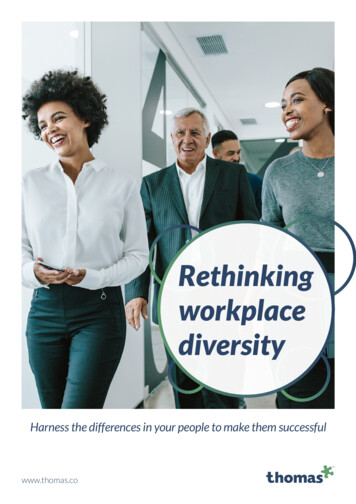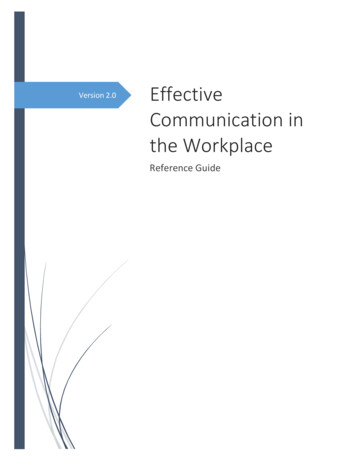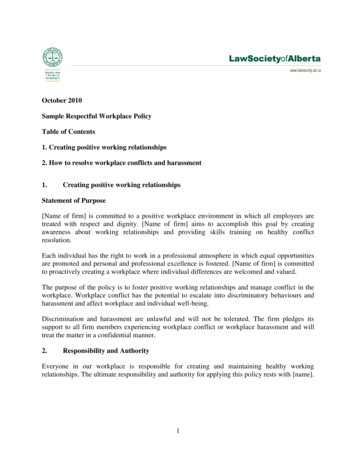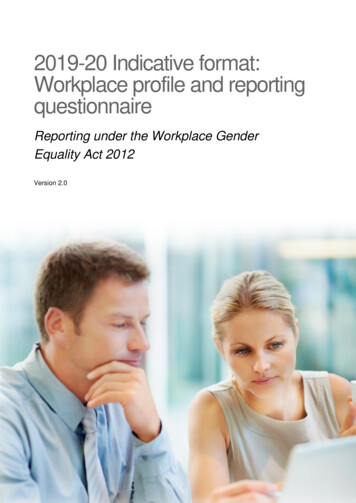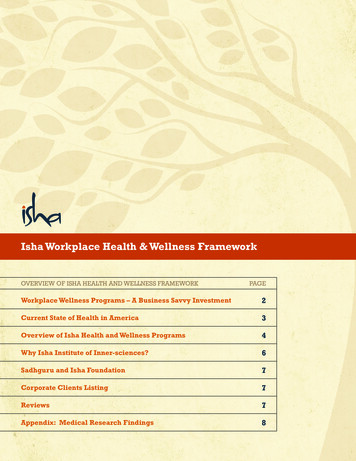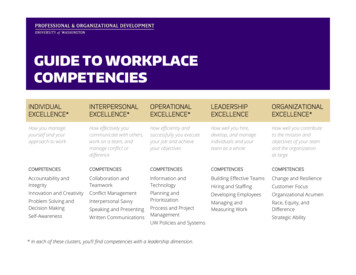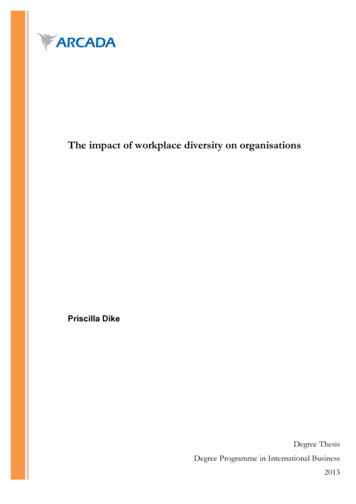
Transcription
The impact of workplace diversity on organisationsPriscilla DikeDEGREE THESISDegree ThesisDegree Programme in International Business2013
ArcadaDegree Programme:International businessIdentification number:Author:Title:Supervisor (Arcada):12631Priscilla DikeThe Impact of Workplace Diversity on OrganisationsSVEINN ELDONCommissioned by:Abstract:The subject matter of this paper is workplace diversity. The study is conducted to explore howcompanies manage workforce diversity and its consequences to the company’s existence aswell as examine how companies’ deal with challenges that comes with employees from diversecultural backgrounds. The research therefore answers the question Has workplace diversitycontributed to organizational success . Because diversity covers a wide range of human attributes and qualities, The research is limited to the required tools for managing workplace diversity, advantages and disadvantages of managing a diverse workforce. Five companies in Finland and Ghana have been studied in order to acquire answers to the question that is being focused on.To gather the required data for this thesis, the author has mostly used the current material thatcontains Human Resource Management studies. Qualitative research method has been used togather and analyze the data on the companies. To answer the research question as well as obtainand practical and relevant information on each company, the author conducted an interview onthree of the companies, and gathered information on the internet on two of the Companies.The result shows that workplace diversity plays an effective role in some companies. Howeverinadequate mentoring and guidance could cause a company low productivity. For this reasonthere must be regular improvement in ways to effectively manage a diverse workforce as theworld keeps advancing.In the conclusion, the findings of the thesis were indicated, which states that workplace diversity has contributed to more productivity but some factors such as differential treatment couldhinder its successful implementation and hence company success. Big companies are more passionate about diversifying their workforce and see its implementation as a norm and continuously strive to improve diversity management, whereas small companies see it as a choice andevitable when they feel it a burden or cannot effectively manage it.Keywords:Diversity, workplace, cultural mentoring, organisation,GlobalisationNumber of pages:59Language:EnglishDate of acceptance:19. 06. 2013
Table of contents1INTRODUCTION .51.1Background of the study.61.2Problems and Hypothesis .71.3Purpose of the Study .71.4Research Question of the Study .81.5Description of Material and Sources.81.6Research Methodology .91.7Limitations of the Study. 102THEORETICAL FRAMEWORK . 122.1Introduction . 122.2Factors to Consider in adopting a diverse workforce . 122.3Effective mentoring Program. 132.4The concepts in diversity management. 142.5Advantages and Disadvantages of Diversity management. 172.5.1Advantages . 172.5.2Disadvantages. 182.6Required tools for managing a diverse workforce. 202.7Cultural mentoring as a tool for managing workforce . 21diversity . 212.8Characteristics of a Good Mentor . 212.8.1Awareness of the outside world: . 222.8.2Having A Global Vision: . 222.8.3Processing a Positive Attitude: . 222.8.4Having Networking Experience: . 232.8.5Possessing some Professional characteristics: . 232.9Reasons for diversity management in organisations . 232.9.1Talent Shortage: . 232.9.2Range of Consumer Need:. 242.9.3Globalisation: . 242.10Barriers to effective diversity management. 242.11Change Management . 25
3COMPANY CASES ON WORKPLACE DIVERSITY. 273.1An Organisation . 273.2Ford motor company. 273.2.1Ford Motors History of Diversity . 283.2.2Global Diversity Vision at Ford. 293.2.3Global Diversity Challenges at Ford . 303.2.4Diversity Management Tools at Ford . 303.3Coca-Cola Company. 313.3.1Introduction . 323.3.2Global Diversity Mission . 323.3.3Diversity challenges at Coca-cola. 333.3.4Successful Diversity implementation Measures. 333.3.5Diversity Education and Training . 343.3.6Coca-Cola diversity management tools. 353.4Miljoy Group . 353.5Dabbousi International Company Limited . 383.6Dastia Siivous Oy . 404LITERATURE REVIEW . 434.1Concerns about Reliability:. 434.2Concerns about Validity:. 434.3Concerns about Generalisability: . 445DISCUSSION . 455.1Outcome of the Study. 465.1.1Extent to Which Companies View Diversity. 465.1.2Diversity at Big Companies, compared to Small ones . 475.2Conclusion and Recommendation . 50REFERENCES . 53APPENDIX
1 INTRODUCTIONDiversity can generally be defined as recognising, understanding and accepting individualdifferences irrespective of their race, gender, age, class, ethnicity, physical ability, race.Sexual orientation, spiritual practice and so on. Grobler (2002:46) also supports this viewby adding that each individual is unique but also share any number of environmental orbiological characteristics.Diversity can be classified into two dimensions. The primary dimension such as age, gender, sexual orientation and so on, exhibits the main differences between various individuals. These primary differences also has the most impact on initial encounters and can beeasily noticed and serve as filters through which people view the world. The secondarydimensions such as religion, education, geographical location, income etc, are those qualities that are not noticeable in the first encounter and can even change throughout differentencounters. These qualities are only noticed after some interactions occur between individuals. (Ashton 2010). Globalization in this recent time has triggered more interactionamongst people from different cultures and backgrounds than before. People are now moreopen-minded in the marketplace worldwide with competition coming from almost everywhere in the continent. Diversity can be a problem to an organisation but could also be asolution, It also comes with its disadvantages but also benefits and dangerous but also constructive. The challenge then is to extract the very essence of diversity and tactically manage it for the improvement of the people and the organization.Most organizations in their own perspective, adopt diversity at their workplace or organisation to become more creative and open to change. Increasing and improving workplacediversity has become an important issue for management in the recent years due to therecognition of how the workplace is changing. Since managing diversity still remains achallenge in organisations, managers tend to learn managerial skills needed in a multicultural working environment and prepares themselves to teach others within their organizations to value cultural differences and treat all employees with dignity. For some businessleaders and managers point of view, diversity is a big challenge to them although it knowsno organizational boundary and has no limitations.5
1.1 Background of the studyDuring the 1960s and 1970s, the United States for the first time saw the need to promoteworkplace diversity. President John F. Kennedy in 1961 recognised a President's Committee on Equal Employment Prospect with the goal of ending discrimination in employmentby the government. The Civil Rights Act of 1964 went further, avoiding discrimination inany activity. The promotion of workplace diversity continued to go further, setting a policyto promote equal employment chances by creating the possibility for the program to continue for a long period of time in any department. It turned out to be a turning point, because it succeeded in avoiding the deliberation of diverse characteristics such as "nationality, human race, skin colour etc." to believing in the principle that to be fair to all, oneneeds to be committed to treating everyone equally.In 1971, the Nixon Administration reviewed the policy in a way to ensure that positiveaction outline with a goal is set. Recent work has queried the meaning of diversity management (for example, Jenner, 1994; Nkomo and Cox, 1996); its ability to lift morale andenhance productivity (for example, Thomas and Ely, 1996) and its underlying paradigms,assumptions and intentions. Litvin (1997) argued against the use of different kinds of persons (women, men, ethnic minorities or majorities, the aged etc) as repositories of difference on the grounds that they are divisive, revitalization debate was conducted by Blommaert and verschueren (1998) to argue that it is not about managing diversity as such, butthat it is about managing the negative side effects of unaccepted diversity: the fight againstracism and discrimination (blommaert and Verschueren, 1998, p. 14, emphasis in original).The various issues raised by these critiques are worrying when so many organisationsseem intent on “diversity management”.Figure 1. An idea of a diverse workforce6
1.2 Problems and HypothesisIt points out that, countless studies have been conducted on work place diversity. Thisstudy is provoked by the gap left unfilled by a substantial number of research works thathas been conducted on workplace diversity and its significance on the corporate culture. Inrecent years Diversity Management and workforce diversity have been substantial and assuch have forced companies to embrace these concepts in their companies with the aim ofincreasing productivity and profit. This forced integration has created divergence and uncertainty in the workforce, as management is not skilled enough to control the concept ofdiversity management and its ethics, and so managers are finding it difficult to effectivelypractice diversity management, which in turn has become an albatross on their neck.Managers find it difficult in knowing the factors that contribute to effective diversity management or the exact leadership tasks that can be achieved to effectively and efficientlydeal with issues related to workplace diversity.In completing this study, relevant theoretical works are considered in order to ascertain thefactors that could lead to the formation of a favorable working environment that pertains todiversity management. In reality, it is also important to establish the implications this hashad on companies so as to create a very conductive working atmosphere through workplace diversity
solution, It also comes with its disadvantages but also benefits and dangerous but also con-structive. The challenge then is to extract the very essence of diversity and tactically man-age it for the improvement of the people and the organization. Most organizations in their own perspective, adopt diversity at their workplace or organi-
